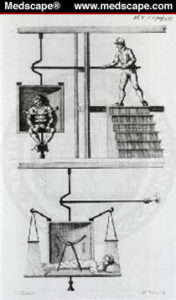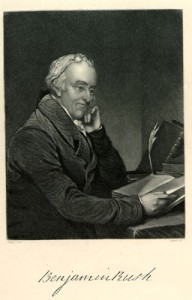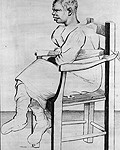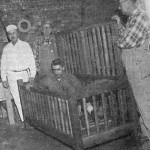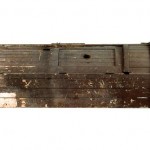Most modern readers would consider the mid-1800s a fairly rough and rugged period, inhabited by correspondingly rough and rugged individuals. However, changes in the treatment of insanity during this period point to the idea that people in the middle 1800s believed they had declined from the vigor of their ancestors. Continue reading
Tag Archives: tranquilizing chair
Better Treatment for the Insane
Early treatments for insanity left much to be desired, but they were infinitely preferable to old-style treatments. In 1916, several authors gave an overview of the progress within the field; they noted that by the mid-1800s, treatment for insanity had begun to include non-medical procedures. Within the non-medical area of treatment, practitioners began to sharply diverge from former practices.
Dr. Benjamin Rush (1745-1813) believed that the people in charge of caring for the insane should control them through fear or intimidation. Rush said, “The first object of a physician when he enters a cell or chamber of the average person should be to catch his eye and look him out of countenance.”
Rush endorsed the use of straitjackets and the tranquilizing chair (see post from 3/30/10), along with depriving a stubborn patient of his “customary pleasant food.” An unusual way through which Rush sought obedience was to “pour cold water under the coat sleeve so that it may descend to the arm pits.”
________________________________________________________________________
Proven Ways to Keep a Troublemaker Quiet
Historically, the treatment of the insane has been riddled with abuse, neglect, and indifference. Restraints were particularly abused, as attendants restrained patients for a variety of reasons: sometimes for safety, sometimes for convenience, and sometimes for punishment. Below are a few popular methods:
1. The crib was a box with a cover and crossbars in which a patient had to lie. Often called a Utica crib for the asylum where it originated, this device was discontinued around 1887.
2. A straitjacket is a shirt-like garment with extra-long sleeves that can be tied at the back of the wearer, whose arms are criss-crossed in front. Many times the ends of the sleeves were sewn shut. Wearing a straitjacket for any length of time can cut off circulation to some extent.
3. Leg locks and chains secured patients to walls and chairs.
4. Dr. Rush developed a tranquilizing chair that restrained an agitated patient in order to slow down the flow of blood.
5. Leather muffs restrained hands by enclosing them in a tight one-piece leather cover. The patient’s hands might be placed in front or in back.
6. A restraining sheet was a fabric sheet with fasteners along the sides. Each fastener was secured to a portion of the bed frame, with the prone patient confined to the space between the mattress and the sheet.
__
______________________
_________________________________

